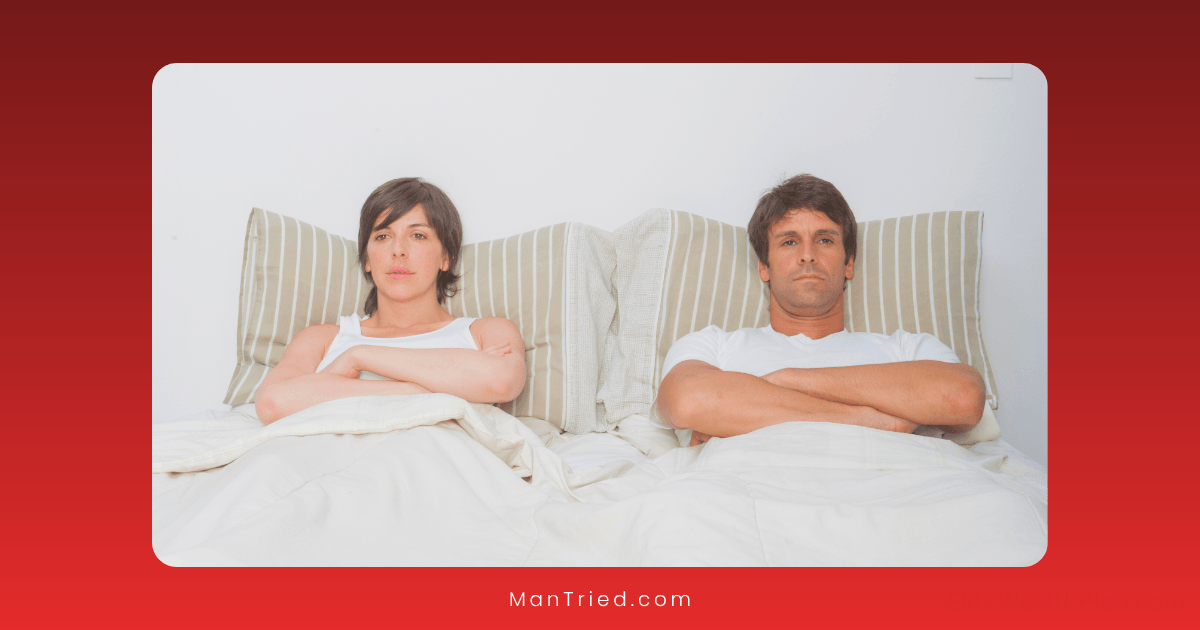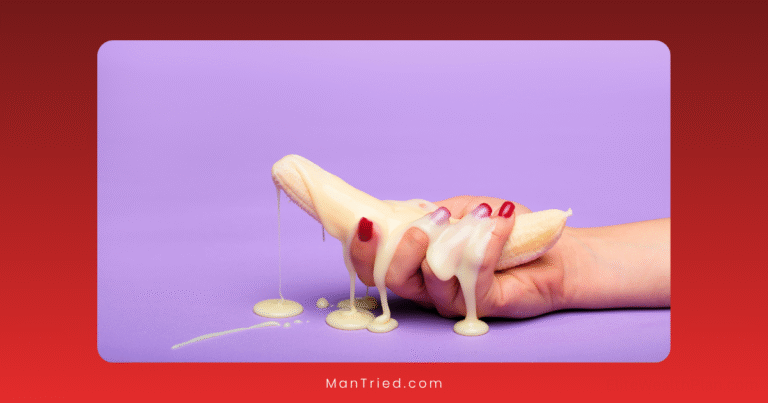Performance Anxiety vs ED: Different Problems Require Different Solutions

When it comes to difficulties with erections, many men (and their partners) lump all issues under the umbrella term “erectile dysfunction” or ED. This oversimplification can lead to frustration, inappropriate treatments, and continued problems in the bedroom.
The reality is that performance anxiety and erectile dysfunction are distinct conditions with different causes, manifestations, and—most importantly—different solutions. Understanding these differences is crucial for addressing the specific issue effectively.
As Dr. Abraham Morgentaler, Associate Clinical Professor of Urology at Harvard Medical School and author of The Truth About Men and Sex, explains: “Treating all erection problems the same way is like prescribing antibiotics for every fever—sometimes you’ll get lucky, but often you’ll be addressing the wrong problem.”
Let’s explore the key differences between performance anxiety and erectile dysfunction, and why each requires a tailored approach.
Defining the Conditions: Similar Symptoms, Different Origins
What is Sexual Performance Anxiety?
Sexual performance anxiety is a psychological condition characterized by excessive worry and intrusive thoughts about one’s ability to perform sexually. These thoughts typically occur before or during sexual activity and can create a cycle of anxiety that interferes with sexual function.
Key characteristics of performance anxiety:
- Primarily psychological in origin
- Often situational (may not occur with all partners or in all settings)
- Frequently accompanied by racing thoughts and self-criticism
- May improve with relaxation and psychological reassurance
- More common in younger men (though it can affect men of any age)
- Usually not present during morning erections or masturbation
What is Erectile Dysfunction (ED)?
Erectile dysfunction is the persistent inability to achieve or maintain an erection sufficient for satisfactory sexual performance. While psychological factors can contribute to ED, it often has underlying physical causes related to blood flow, hormones, or nerve function.
Key characteristics of ED:
- Often has physical/organic causes
- Tends to be consistent across different situations
- Develops gradually in most cases (unless due to injury or medication)
- Usually doesn’t respond to psychological reassurance alone
- Increases in prevalence with age (affecting approximately 40% of men at age 40 and 70% by age 70)
- May affect all forms of erection, including morning erections and during masturbation
The Science Behind the Difference
The Physiology of Performance Anxiety
Performance anxiety triggers the body’s stress response, activating the sympathetic nervous system—the “fight or flight” mechanism. This response:
- Releases stress hormones like adrenaline and cortisol
- Diverts blood flow away from the genital region to major muscle groups
- Increases muscle tension throughout the body
- Elevates heart rate and blood pressure
- Interferes with the parasympathetic nervous system, which is responsible for sexual arousal
This physiological cascade makes it difficult to achieve or maintain an erection, despite there being no underlying physical issue with the erectile mechanism itself.
The Physiology of Erectile Dysfunction
Erectile dysfunction typically involves a disruption in one or more of the physical systems required for erection:
- Vascular issues: Reduced blood flow to the penis due to atherosclerosis, hypertension, or diabetes
- Neurological factors: Nerve damage from conditions like multiple sclerosis, Parkinson’s disease, or diabetic neuropathy
- Hormonal imbalances: Low testosterone or thyroid disorders
- Structural abnormalities: Peyronie’s disease or injuries to the penis
- Medication side effects: Particularly from antidepressants, blood pressure medications, or antihistamines
Research published in the Journal of Sexual Medicine indicates that up to 80% of ED cases have an underlying physical cause, while the remaining 20% are primarily psychological or mixed in origin.
Prevalence and Demographics: Who’s Affected?
Performance Anxiety Statistics
- Affects approximately 5-25% of men
- Higher prevalence in younger age groups (20s-30s)
- Often occurs during new sexual relationships or after negative sexual experiences
- Frequently reported by men with high-stress lifestyles or perfectionist tendencies
A 2022 study published in the Journal of Sex Research found that up to 90% of teenage and young adult males report experiencing performance anxiety at some point, though for most it’s an occasional rather than chronic issue.
Erectile Dysfunction Statistics
- Affects approximately 30 million men in the United States
- Prevalence increases significantly with age
- Affects about 40% of men at age 40, rising to 70% by age 70
- Strongly correlated with cardiovascular disease, diabetes, and metabolic syndrome
- Projected to affect 322 million men worldwide by 2025
According to research from the Massachusetts Male Aging Study, complete ED triples from 5% to 15% between ages 40 and 70, while moderate ED doubles from 17% to 34%.
The Diagnostic Difference: How Each Condition Is Identified
Diagnosing Performance Anxiety
Performance anxiety is typically diagnosed through:
- Patient history: Pattern of erectile issues that correlate with anxiety-producing situations
- Psychological assessment: Evaluation of anxiety levels, thought patterns, and stressors
- Ruling out physical causes: Normal morning erections and ability to achieve erections during masturbation often indicate psychological rather than physical issues
- Response to situation changes: Improvement when pressure is removed or with different partners
Diagnosing Erectile Dysfunction
ED diagnosis usually involves:
- Comprehensive medical history: Review of chronic conditions, medications, and lifestyle factors
- Physical examination: Assessment of genital anatomy and secondary sex characteristics
- Laboratory tests: Blood tests for glucose, cholesterol, testosterone, and other relevant markers
- Specialized tests: In some cases, nocturnal penile tumescence testing (measures erections during sleep) or Doppler ultrasound (evaluates blood flow)
- Cardiovascular assessment: ED is often an early warning sign of cardiovascular disease
Dr. Michael Reitano, Physician in Residence at Roman Health, notes: “One of the most important aspects of proper ED treatment is accurate diagnosis. Many men with performance anxiety are unnecessarily prescribed ED medications when what they really need is psychological support.”
Treatment Approaches: Different Problems, Different Solutions
Effective Treatments for Performance Anxiety
- Cognitive Behavioral Therapy (CBT)
- Identifies and challenges negative thought patterns
- Teaches techniques to manage anxiety in the moment
- Research shows 60-70% improvement rates with 8-12 sessions
- Mindfulness-Based Approaches
- Focuses on present-moment awareness
- Reduces self-monitoring and spectatoring
- A 2019 study in the Journal of Sexual Medicine found mindfulness training reduced performance anxiety by 42%
- Sensate Focus Exercises
- Non-demand pleasuring techniques developed by Masters and Johnson
- Gradually reintroduces sexual touch without performance pressure
- Effective for 83% of couples with anxiety-related sexual issues
- Communication and Relationship Therapy
- Addresses relationship dynamics that may contribute to anxiety
- Improves communication about sexual needs and concerns
- Particularly effective when both partners participate
- Lifestyle Modifications
- Stress reduction techniques (meditation, yoga, deep breathing)
- Regular exercise (improves mood and reduces anxiety)
- Limiting alcohol and avoiding recreational drugs
- Improving sleep quality
Effective Treatments for Erectile Dysfunction
- Oral Medications (PDE5 Inhibitors)
- Sildenafil (Viagra)
- Tadalafil (Cialis)
- Vardenafil (Levitra)
- Avanafil (Stendra)
- Success rates of 65-85% depending on underlying cause
- Other Medical Interventions
- Intracavernosal injections (alprostadil, Trimix)
- Vacuum erection devices
- Penile suppositories (MUSE)
- Testosterone replacement therapy (if deficient)
- Success rates vary by treatment and individual factors
- Surgical Options
- Penile implants (inflatable or malleable)
- Vascular surgery (for specific cases of arterial blockage)
- 90-95% satisfaction rates reported for penile implants
- Shockwave Therapy
- Low-intensity extracorporeal shockwave therapy (Li-ESWT)
- Promotes neovascularization (growth of new blood vessels)
- Emerging evidence shows promise for vasculogenic ED
- Treatment of Underlying Conditions
- Managing diabetes, hypertension, or heart disease
- Addressing hormonal imbalances
- Modifying medications that may contribute to ED
- Can resolve ED in 30-40% of cases when successful
When Problems Overlap: The Anxiety-ED Cycle
It’s important to note that performance anxiety and ED can coexist and reinforce each other in what specialists call the “anxiety-ED cycle”:
- A man experiences an episode of erectile difficulty (from either psychological or physical causes)
- This creates anxiety about future sexual performance
- The anxiety triggers the stress response during subsequent sexual encounters
- This stress response makes erections more difficult
- The cycle continues and intensifies
Breaking this cycle often requires addressing both the psychological and physical components simultaneously. A 2023 study in the International Journal of Impotence Research found that men with mixed psychological and organic ED had the best outcomes when receiving combination therapy (both psychological intervention and medical treatment).
Case Studies: Tailoring Treatment to the Real Problem
Case 1: Mark, 28 – Performance Anxiety Misdiagnosed as ED
Mark sought help after experiencing erectile difficulties with his new girlfriend. Despite being prescribed sildenafil (Viagra) by his primary care physician, he saw only modest improvement and continued to feel anxious about sex.
Upon further evaluation, it became clear that Mark had no issues with morning erections or during masturbation. His difficulties began after an embarrassing experience where he lost his erection during his first night with his new partner. His anxiety about it happening again created a self-fulfilling prophecy.
Effective solution: Mark worked with a sex therapist who used cognitive behavioral therapy to address his anxiety. He and his partner also practiced sensate focus exercises that removed performance pressure. After six weeks, Mark reported significant improvement and no longer felt dependent on medication.
Case 2: Robert, 58 – ED with Secondary Performance Anxiety
Robert gradually developed erectile difficulties over two years. Initially, he attributed it to stress at work, but the problems persisted even during relaxed weekends and vacations. He became increasingly anxious about his performance, which further complicated the situation.
A thorough medical evaluation revealed early-stage type 2 diabetes and hypertension—both conditions that can damage blood vessels and impair erectile function.
Effective solution: Robert’s treatment plan included:
- Medical management of his diabetes and hypertension
- A daily PDE5 inhibitor (tadalafil)
- Lifestyle modifications including diet changes and regular exercise
- Several sessions with a therapist to address the performance anxiety that had developed
Within three months, Robert reported reliable erections and significantly reduced anxiety about sexual performance.
When to Seek Professional Help
Signs You May Be Experiencing Performance Anxiety:
- Erection problems occur situationally (with certain partners or in specific settings)
- You have normal morning erections and can achieve erections during masturbation
- Anxiety symptoms (racing heart, intrusive thoughts) precede erectile difficulties
- Problems began suddenly, often after a stressful or negative sexual experience
- You’re under significant life stress or experiencing relationship difficulties
Recommended professionals: Sex therapist, psychologist specializing in sexual health, or relationship counselor
Signs You May Be Experiencing Erectile Dysfunction:
- Erection problems occur consistently across different situations
- Difficulty with erections developed gradually over time
- Morning erections have diminished or disappeared
- You have risk factors such as diabetes, heart disease, or hypertension
- You’re taking medications known to affect sexual function
- Other symptoms are present (reduced libido, fatigue, depression)
Recommended professionals: Urologist, sexual medicine specialist, or endocrinologist (if hormonal issues are suspected)
The Path Forward: Personalized Solutions for Better Sexual Health
Understanding whether you’re dealing with performance anxiety, erectile dysfunction, or a combination of both is the first step toward effective treatment. Here’s a roadmap for addressing your concerns:
- Self-assessment: Consider the patterns and context of your erectile difficulties
- Professional evaluation: Seek appropriate medical or psychological assessment
- Honest communication: Discuss concerns openly with healthcare providers and partners
- Tailored treatment: Pursue solutions specific to your diagnosis
- Patience and persistence: Sexual health improvements often take time
Remember that both performance anxiety and erectile dysfunction are common and treatable conditions. With the right approach, the vast majority of men can return to satisfying sexual experiences.
Dr. Irwin Goldstein, Director of Sexual Medicine at Alvarado Hospital, emphasizes: “The most important message for men experiencing erection problems is that help is available, but the right help depends on the right diagnosis. Taking time to understand the true nature of the problem leads to more effective solutions and better outcomes.”
Conclusion: Moving Beyond the One-Size-Fits-All Approach
Performance anxiety and erectile dysfunction may share some symptoms, but they are fundamentally different conditions requiring different approaches. Understanding these differences empowers men to seek appropriate care and avoid the frustration of ineffective treatments.
Whether the solution lies in psychological techniques, medical interventions, or a combination of both, the key is personalized care that addresses the specific underlying causes of erectile difficulties. With proper diagnosis and targeted treatment, most men can overcome these challenges and enjoy a fulfilling sex life.
Have you experienced confusion about performance anxiety versus erectile dysfunction? Share your thoughts in the comments below.






